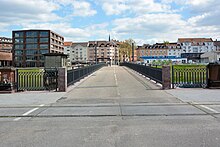Devil's Bridge (Mannheim)
The Teufelsbrücke is the oldest surviving bridge in Mannheim and dates from the early industrial age . It is a cultural monument and, as the middle of the three movable bridges, leads over the connecting canal built in 1874, a harbor basin in the Mannheim trading port between the Jungbusch district and the Mühlauinsel. The other two bridges are the Neckarvorlandbrücke and the Spatzenbrücke.
history
The Devil's Bridge was built between 1874 and 1878. In 1902/03 a new superstructure made of sheet metal girders and a new drive as a swing bridge were implemented by the MAN company . It was used for freight and passenger traffic via the connecting channel. In 1972 it was placed under monument protection. It has not been turned since the 1970s, but the drive technology, which is over 100 years old, is still there. The extended Jungbuschstrasse has been running over the Teufelsbrücke since the 1920s . Due to the corrosive condition of the bridge, access has been blocked by bollards since 2004.
description
The bridge is an asymmetrical swing bridge. The pivot is on the western abutment . The span of the bridge is small. The abutments therefore protrude far into the harbor basin on both sides and form long bridgeheads made of retaining walls with cladding made of red sandstone . They probably come from the original bridge from the construction time of the connecting canal, including the access roads.
The bridge is combined with a lock system that is intended to prevent a flow from the Neckar through the harbor basin. On the north side of the bridge there is a double-leaf mitred gate with drive via free-standing hand winches and bevel gears and racks on both sides . The gate has been mechanically locked and permanently locked since 2008.
technology
Since 1902/03 the bridge had a riveted sheet metal girder with sidewalks on both sides on riveted sheet metal girders. These were removed as part of the 2015 renovation. The center of gravity of the moving part is above the pivot point on the western abutment. Because of the asymmetrical shape, the landside end of the superstructure on the Mühlauinsel side serves as a counterweight to the part above the fairway.
The pivot pin with roller ring and gear segment enables a rotation of 90 degrees. There is a connection to the machine housing via mechanics with bevel gears, shaft and roller chain . The bridge releases further mechanics on the pivot so that it can be rotated clockwise parallel to the fairway in order to open the passage.
In the engine house, which separately on the north side of the western bridgehead on sandstone pedestals stands, is the electric drive with a three-phase - wound rotor motor . If necessary, the mechanics can also be moved using a hand crank. Besides the electrical system, the technology is still in the same condition as it was in 1902.
The Teufelsbrücke was electrified in 1892–93. This makes it the oldest existing building in Mannheim with a power supply.
Demolition plans
The Teufelsbrücke forms a passage barrier for shipping in the connecting canal. The access to the southern part is difficult because of two further movable bridges (Mühlau Bridge and Spatzenbrücke) that have to be passed. Due to the increased throughput, especially in container traffic , the existing infrastructure for the use of the connecting canal, even by wider ships in the 21st century, was increasingly assessed as no longer meeting the requirements. Detours for the ships, hindrances for container traffic due to the renovation or conversion and the maintenance of two movable bridges should be avoided. The reconstruction and traffic concept of the State Port Company therefore aimed to demolish the Devil's Bridge.
An initiative from local residents fought against these plans for several years. On the one hand, longer footpaths and poorer transport connections to their city quarter were feared; on the other hand, the bridge with its mechanical equipment is to be preserved as a monument from the heyday of Mannheim's industrialization and the early days of the Mannheim ports.
Redevelopment
At the end of November 2014, the city of Mannheim granted permission under monument law to renovate the Teufelsbrücke. According to this, the renovation measures carried out in 2015 "restored the historical appearance of the bridge and also ensure the continued existence of the technical cultural monument, which is unique in Mannheim".
However, this renovation only related to measures to a limited extent: the cantilevers with the sidewalks were removed on both sides, the masonry was provided with a sandstone-colored concrete border and a new railing - with a historical appearance, but without Art Nouveau ornaments - and street lamps were installed. The machine house remained excepted from the renovation, especially with a leaky and partially crumbled roof. The donation made by a private person in the summer of 2018 enabled the necessary measures to maintain the house.
Web links
- Devil's Bridge in Mannheim. Rhein-Neckar industrial culture, accessed on November 19, 2014 .
- Albert Gieseler: The Devil's Bridge - description, history, technology and justification for its preservation. (RTF 21 KB) Retrieved November 19, 2014 .
Individual evidence
- ↑ MARCHIVUM: street names, Extended Jungbuschstraße. Retrieved August 27, 2018 .
- ^ City of Mannheim, cultural monuments
- ↑ www.mannheim.de: Approval granted under monument law - Teufelsbrücke is being renovated. November 28, 2014, accessed November 28, 2014 .
- ↑ Mannheimer Morgen of August 22, 2018, page 13, the final touches for the Teufelsbrücke .
Coordinates: 49 ° 29 ′ 39.3 " N , 8 ° 27 ′ 20.9" E





